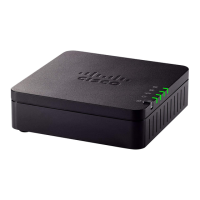DescriptionField
These codes let the ATA know what to do when you are listening to
the first or second dial tone.
One or more *codes can be configured into this parameter, such as *72,
or *72|*74|*67|*82, and so on. The maximum length is 79 characters.
This parameter applies when you have a dial tone (first or second dial
tone).
After receiving dial tone, you enters the *code and the target number
according to current dial plan. For example, after you dial *72, the ATA
plays a special tone called a Prompt tone while awaiting you to enter a
valid target number. When a complete number is entered, the ATA
sends a INVITE to *72 target_number as in a normal call. This feature
allows the proxy to process features like call forward (*72) or Block
Caller ID (*67).
The *codes should not conflict with any of the other vertical service
codes internally processed by the ATA. You can remove a corresponding
*code that you do not want to the ATA to process.
You can add a parameter to indicate which tone plays after the *code
is entered, such as *72‘c‘|*67‘p‘. Below is a list of allowed tone
parameters (note the use of open quotes surrounding the parameter,
without spaces).
'c' = <Cfwd Dial Tone>
'd' = <Dial Tone>
'm' = <MWI Dial Tone>
'o' = <Outside Dial Tone>
'p' = <Prompt Dial Tone>
's' = <Second Dial Tone>
'x' = No tones are placed, x is any digit not used above.
If no tone parameter is specified, the ATA plays Prompt tone by default.
If the *code is not to be followed by a phone number, such as *73 to
cancel call forwarding, do not include this parameter. Instead, add the
*code in the dial plan and the ATA send INVITE *73@..... as usual
when you dial *73.
Default setting: blank
Feature Dial Services Codes.
Cisco ATA 191 and ATA 192 Analog Telephone Adapter Administration Guide for Multiplatform Firmware
68
Voice Settings Configuration
Vertical Service Activation Codes

